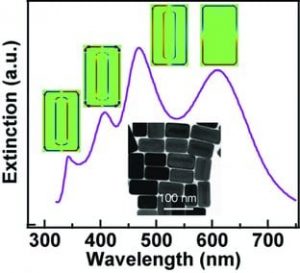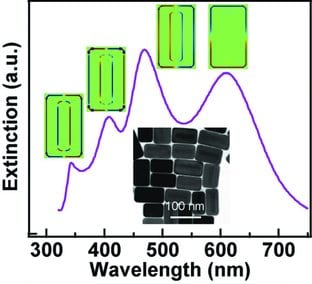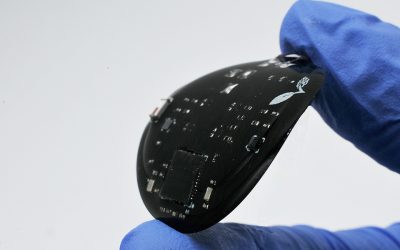 Localized surface plasmon resonances have recently received intense attention due to their intriguing and complex optical properties. Gold and silver nanostructures, which produce resonances located in the visible range and are stable under ambient conditions, have been studied extensively from fundamental sciences aspects as well as due to their numerous potential applications. Both materials have their advantages. Silver nanocrystals exhibit larger field enhancements, higher refractive index sensitivities, and larger solar energy conversion efficiencies than gold nanocrystals. However, gold nanostructures show tunable longitudinal plasmon wavelengths, are chemically stable and facile growth methods exist. (Gold core) − (silver shell) nanostructures with different shapes have been fabricated to combine these advantages and to allow for tailoring of the plasmon wavelengths by varying the thickness. However, the exact nature of the plasmonic properties of these structures has not been investigated systematically and still remains controversial.
Localized surface plasmon resonances have recently received intense attention due to their intriguing and complex optical properties. Gold and silver nanostructures, which produce resonances located in the visible range and are stable under ambient conditions, have been studied extensively from fundamental sciences aspects as well as due to their numerous potential applications. Both materials have their advantages. Silver nanocrystals exhibit larger field enhancements, higher refractive index sensitivities, and larger solar energy conversion efficiencies than gold nanocrystals. However, gold nanostructures show tunable longitudinal plasmon wavelengths, are chemically stable and facile growth methods exist. (Gold core) − (silver shell) nanostructures with different shapes have been fabricated to combine these advantages and to allow for tailoring of the plasmon wavelengths by varying the thickness. However, the exact nature of the plasmonic properties of these structures has not been investigated systematically and still remains controversial.
Now, Jianfang Wang and co-workers from The Chinese University of Hong Kong have for the first time unraveled the nature of the plasmon bands on gold-silver nanorods. They started with two differently sized gold nanorods and coated them with silver shells with systematically varied thicknesses. The evolution of the plasmon bands, their peak wavelengths and extinction intensities as functions of the shell thickness were studied. The nature of each plasmon band was determined unambiguously with finite-difference time-domain (FDTD) simulations. This first systematical study on the plasmon resonances of gold-silver nanorods will be useful for the construction of optical devices as well as for plasmon-enhanced spectroscopy techniques.
The research was reported in Advanced Optical Materials, a new section in Advanced Materials dedicated to breakthrough discoveries and fundamental research in photonics, plasmonics, metamaterials, and more, covering all aspects of light-matter interactions. To get Advanced Optical Materials email alerts click here.

















